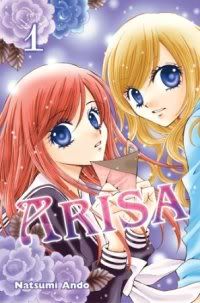Arisa by Natsumi Ando
Summary: Tsubasa Uehara, a girl with a reputation of being a delinquent with bad grades, is just a bit jealous of her twin sister Arisa Sonoda whom she hasn’t seen in three years. Her sister seems to be everything she wishes she could be, smart, pretty, kind, and surrounded by good (female) friends. But when Arisa attempts suicide Tsubasa realizes that something is up and impersonates Arisa at her school to realize how a simple, wish-granting, cell-phone game could lead to all of this.
The Good: In the words of Carlo Santos (who writes the Right Turn Only column on Anime News Network), Arisa is “a shojo version of Naoki Urasawa” and from what I’ve read of Urasawa’s works* that seems about right. The story is darker than expected and it seems like nearly every major character is plotting or scheming something in the shadows and it really isn’t clear who’s manipulating the strings right now or what they hope to achieve in the end.
The Bad: As you can see from the premise, the story does have it’s fair number of tropes and clichés which can seem a tad unbelievable at times. Some bits of the story might be explained later on, such as how all the wishes are fulfilled so I’m not going to write it all off yet, but if you can deal with the “twins switching places and no one notices” start then you should be able to tolerate everything else that happens. The story is also paced a bit on the slow side but hopefully things will speed up in later volumes.
The Art: The art looks like fairly standard shojo art but like standard shojo art so for me that wasn’t a problem at all. The lines were clean, there weren’t too many screentones, the panel arrangement was logical so it wasn’t hard to figure out what to read next so I think the art was successful in telling the story.
I also really liked how there was a short preview of the next volume in the back of each book, probably because it was in Japanese and I remembered enough of what happened next that I was able to translate the bubbles without too much trouble (using a dictionary of course, my Japanese is still super basic). Currently the story is still ongoing with 8 volumes published in Japan and five in the US and I have no idea if the series is close to finishing up soon but I plan on continuing the series until the end.
